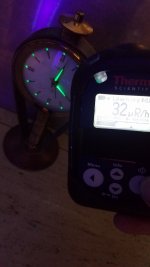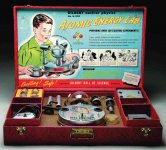UnderMiner
Silver Member
- Jul 27, 2014
- 3,778
- 9,633
- 🥇 Banner finds
- 2
- Detector(s) used
- Minelab Excalibur II, Ace 250
- Primary Interest:
- All Treasure Hunting
- Thread starter
- #21
Any updates? I've sometimes thought about purchasing a frisker for this same reason - just poking around - but the ones that I want cost a bit more than I'd like to pay. Living through someone else's experiences vicariously is almost as good.
I went to the thrift store this morning with my radiation detector and I found a very nice antique Swiss wind-up clock with a beautiful Radium-painted dial. Another person was looking at it but he put it down. I picked it up and put my detector to it to see if it was as radioactive as it looked - the detector went crazy - 32 Microrem per hour with a peak of 132 Gamma counts per second. So I paid the $5.99 for it and took it home. At home I sprayed it with some canned air and the beautiful Swiss mechanism inside began ticking. So now I have this very unique radioactive clock to ad to my every expanding collection of radioactive antiques. Under black light you can really appreciate the beauty of a Radium dial clock.





Edit: I found the above image of the original 1962 advertisement for the clock. The ad describes the clock as "luminous", but fails to mention that the clock is also highly radioactive haha, that wouldn't be good for business.
Last edited:



